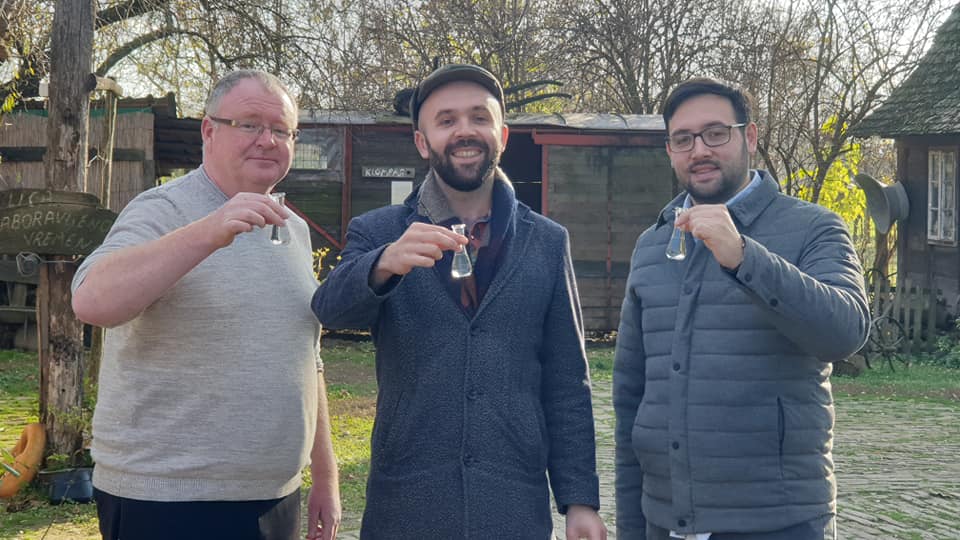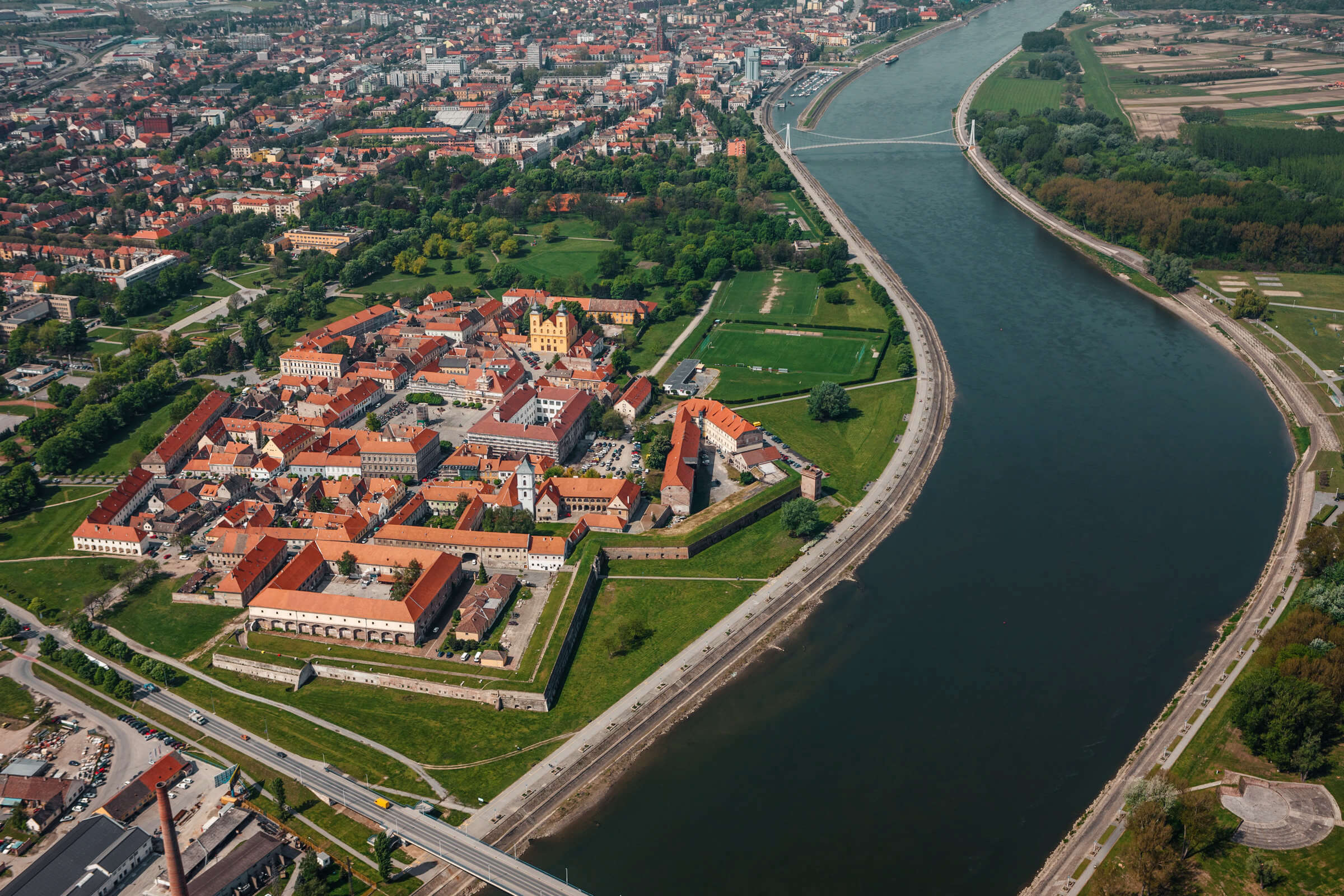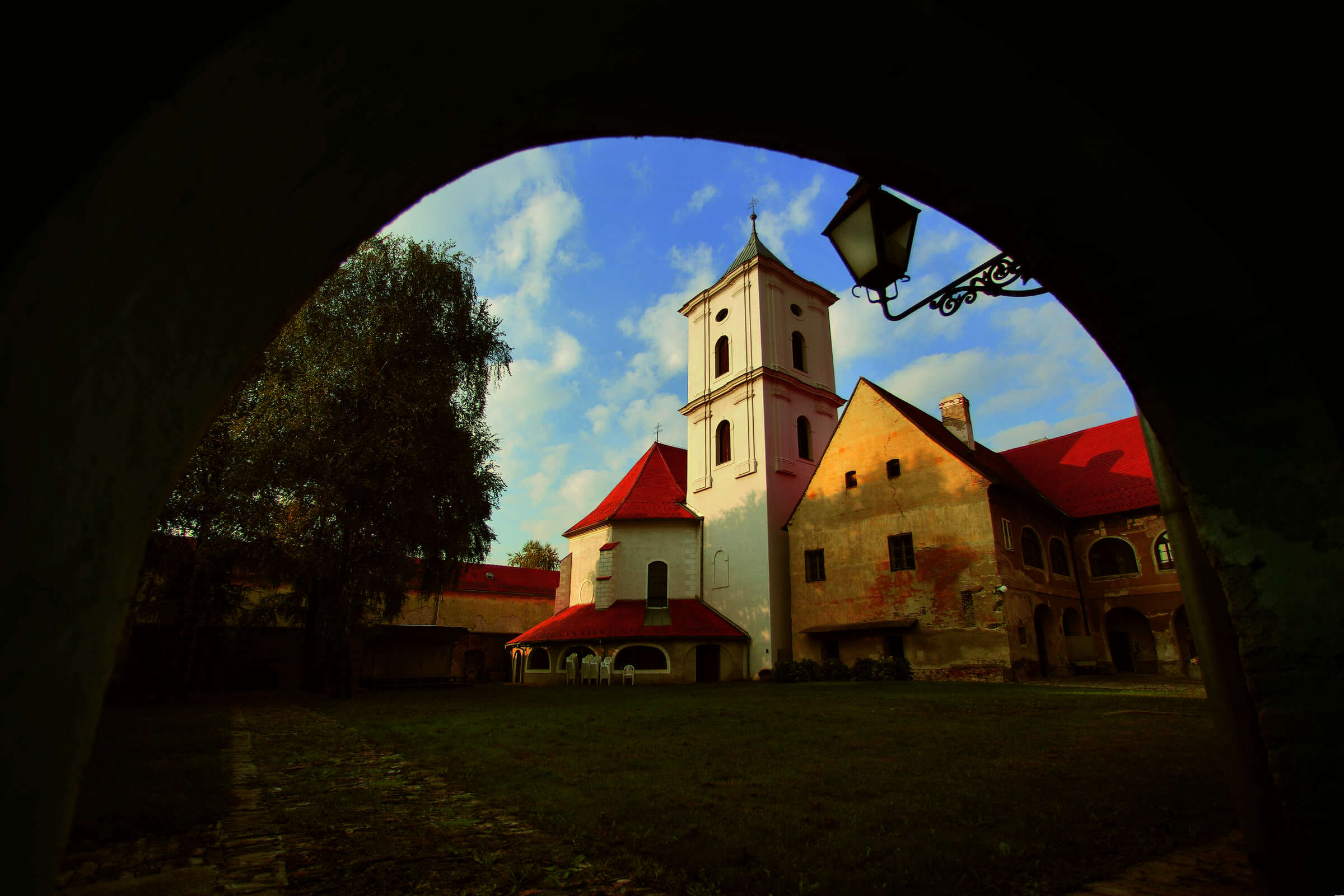Extreme Rakija: 10 Unusual Uses of Slavonia's Favourite Friend
November 26, 2021 - I am still recovering from my body being marinated in rakija on last week's tour of Slavonia. But rakija is not just for drinking. Ten things and uses you need to know about the culture of extreme rakija.
As part of my detox, I posted on Facebook a few days ago, asking people to name their most unusual usage of this very fabric of Slavonian society, as well as their most (un)memorable moment. Here are three of the many answers.
My great grandma used to slather rakija on her entire body every morning (like someone less extreme would put on body lotion). I don't think she's ever had a cold in her life.My great grandma used to slather rakija on her entire body every morning (like someone less extreme would put on body lotion). I don't think she's ever had a cold in her life.
Use it for hair massage. It runs blood circulation so fast that you will have long hair overnight after massage. (Editor's note - I tried this but the bald patch is still there.)
In Croatia there is a famous cocktail called dum-dum vodka. Mix vodka and sprite, cover the glass with your hand and hit the table a few times. When we ran out of vodka, we decided to go for dum-dum rakija and use the motorbike helmet on my head instead of the table. Numerous dum-dum-dum's followed after that. That was a shaky experience!
There was clearly an article to be written, but not only is my time very limited at the moment due to last week, but also why reinvent the wheel when there are experts with time on their hands.
I decided to contact one of the most dangerous and entertaining men I have met in Croatia - last week's guide, Domagoj Butkovic of the outstanding Kulen Travel.
Rakija - nectar of the Gods. Universal medicine. Tradition deeply rooted in history. When in Croatia - you can run but you can't hide from Rakija. And don't you dare to refuse one when offered, because you will be forever marked.
This 40% alcohol fruit distillate is a solution to many problems. Plum, pear, apple, quince, apricot, you name it we have it! A good old saying goes: A psychiatrist can help, but rakija is less expensive.
Let's go together through some unusual uses of this God given liquid.
1. The way to prove who is the boss
The easiest way to tell who's the head of the household is to just look at rakija production. If more plums from the orchard go for marmalade, the lady is in charge. If more plums go for rakija, the man is in charge.
2. Cleaning
Sunday family lunch is prepared and your kitchen floor is full of greasy stains? Don't worry, rakija is here to save the day! Sweep the floor with rakija and make those tiles shine once again!
3. Numbing the pain
Probably the most famous use of rakija is to numb the pain. No matter if it is toothache, headache or heartache, rakija will make all the problems go away. Doctors suggest taking a shot 3 times a day, every 8 hours.
4. Antifreeze
It's a cold winter day and your car ran out of antifreeze. How many times have you found yourself in this situation? Take a sip of rakija, pour the rest of the bottle in your car and watch it defrost.

5. Rakija-powered Tomos
Believe it or not, legend has it that the famous motorcycle Tomos can run on rakija. The only trouble is a liter of rakija is far more expensive than a liter of gasoline, but maybe not for too long.
6. Lowering the body temperature
Smell of rakija reminds us of being sick. When we were kids, our grandmas were the ones taking care of us, and grandmas know best. Socks and scarves dipped into rakia and then worn are the best way to lower your temperature.
7. Disinfection
In this day and age we all know how important disinfectants are. Spray rakija on your hands and all the unwanted germs and bacteria will be gone in the blink of an eye. Take a shot after to do the same with your throat.
8. Good luck charm
After a baby is born, a bottle of rakija is buried underground. This rakija is to stay buried until the event of a great meaning - usually wedding. Opening that bottle of rakija and serving it to guests means good luck.

(TCN in familiar Slavonian drinking pose with Kulen Travel's Domagoj Butkovic and Stanko Skrobo at the phenomenal Baranjska Kuca in Karanac)
9. Better than a contract
When you buy something, settle a deal or get a job, you are supposed to have a rakija with everyone who you meet shortly after. This tradition is called aldumash and it is here to make sure your new contract is going to last.
10. Skin cleaning
A well hidden secret from many of us is that rakija can be used to clean the skin of your face. It's not as strong as medical alcohol and it does have antioxidants and vitamins which are good for your skin. You might smell funny, but you will look nice!
Looking for more extreme rakija insights? Check out the TC Rakija, Disconnecting People guide.
How to Invite People to Rakija and 19 More Must-Visit Things in Osijek
September 24, 2020 - The biggest town in the heart of Slavonia, we present 20 must-visit things in Osijek.
A city where storks live on city buildings, red wounds on facades reminiscent of days of courage, and street art testifies to the city’s past and present rhythm. As Punkufer reports, whether you are a fan of wineries and vineyards, old castles and forts, or you want to enjoy the romantic combination of the Drava and the Danube in the middle of golden and green plains, Osijek is the place for you.
1. The famous Osijek Fortress
The fortified part of the town from the 18th century, you'll find St. Trinity's statue. There is also the General Command Building, which you've seen elsewhere even if you have not been to Osijek - on the 200 kn banknote, which also has the floor plan of the old fortress.
At the time of its construction, it was one of the largest and most modern military fortifications in Central Europe. To this day, only a small part of the old walls has been preserved. It is believed that the body of General von Beckers, who led the construction of the wall, is in the walls of the Fortress. But there are more intriguing legends and beliefs…

Osijek | Photo by Romulic and Stojcic
2. City of legends
The legend of the missing treasure: when Napoleon was ravaging Europe, the treasury of the Habsburg Empire was transferred on ships among the safe walls of the Osijek Fortress. After the danger passed, the treasury was returned, but one chest disappeared forever in Osijek, and it was never known where the money was.
Legend of noon lunch: when the Turkish army left the city in 1687, churches marked the period of freedom with bells at 11 am, and Osijek housewives eventually concluded that this was the ideal time to make dumplings that would be ready at noon. Hence the name "dumpling clock", but also dumplings on your table at noon.
The legend of Romeo and Juliet in Osijek: cops in ancient times caught a young man in the wee hours of the night and accused him of crime nearby. To save the reputation of his sweetheart with whom he spent the night, he confessed to a crime he did not commit. When she found out, she ran to the rescue to admit what had happened; however - the young man had already been hanged. The remainder of this event today is the Chapel of the Stone Cross, or as the people once call it - the Chapel of Unhappy Loves.

Osijek | Photo by Romulic and Stojcic
3. Soldiers, inns, and prostitutes
At the end of the summer, the Tourist Board of the City of Osijek organized free tourist tours of the Fortress called "Fortress: soldiers, inns and prostitutes" (only for adults!). The perfect opportunity to meet the naughty side of Osijek.
The tours are led by a friendly tourist guide Stanislav Subotic, who welcomed his guests disguised as a resident of the Lower Town, whom the woman reported to the police that he had not returned from the prostitute for six weeks. The Museum of Slavonia and young historians from the Faculty of Philosophy in Osijek also helped him prepare the tour. At the moment, they no longer have free tours, but those interested in a thematic tour can contact the Osijek Tourist Board and Mr. Subotić, who will surely enhance their experience of the city.

Osijek | Photo by Romulic and Stojcic
4. Osijek is one of the greenest cities in Croatia, and sphinxes guard the entrance to a park
Large parks and gardens, especially those around the fortress's ramparts, were built on the principle of ‘pleasant and useful’ to keep the city away from cannons from the city walls. During your visit to Osijek, you can enjoy the greenery of the park of King Tomislav, the gardens of Croatian kings, or the young Park of the newlyweds, where young married couples once planted the trees of their love.
One of the more unusual parks is Sakuntala Park. It was named after a girl from Indian mythology who was sung by Indian poets and Goethe. The park is adorned with sphinxes at the entrance, and when you see them, you’ll remember why we warned you: Their eyes are up!

Osijek | Photo by Romulic and Stojcic

Osijek | Photo by Romulic and Stojcic
5. "Kompa" (Friend), tireless scaffolding on the Drava
For a hundred years, Kompa has been tirelessly transporting passengers from one bank of the Drava to another, often when they intend to visit the Osijek ZOO on the other side. This is why many people remember their childhood when they sailed on a trip with their parents.
This ecological boat uses only the Drava River's currents for driving, but don't worry, so as not to end up in a panoramic tour of Slavonia and Srijem on the Danube, your comp holds a steel rope. Of course, you always have the option to eLEGAntly* cross the Drava River over the Pedestrian Bridge (Bridge of Youth).
*Lega is a name for a friend, a colleague, in the spirit of the Osijek dialect.
6. Copacabana Beach or locally - Kopika
To refresh in the summer months, locals and guests alike prefer to look for in public baths and swimming pools. The largest and most visited Drava beach is called Copacabana. With a thorough and systematic reconstruction, there is a recreation center that will soon shine in a new edition.
It is ideal for walking along the Drava Promenade along the Drava, where there is enough space for walking, cycling, or enjoying the view on a bench or with a cup of coffee in one of the "river" cafes.

Osijek | Photo by Romulic and Stojcic
7. Slavonian cuisine to protect against winter
Fresh cheese with kajmak, Kulen, fried bacon, meatballs, fish stew, river specialties of carp and catfish, shepherd's pie, Sataraš, cabbage flakes, plum dumplings, jam, chocolate from Osijek factory Kandit… Need we say more? With all that, you can refresh yourself with a homemade invention: a black Radler. After all, they say that Osijek is still the birthplace of the first Croatian beer. And for wine lovers, there is the best from the famous wine cellars of Slavonia and Baranja: Pinot, Chardonnay, Merlot, Grasevina…

Osijek | Photo by Romulic and Stojcic
8. Mother of cats
Here is a temple for all crazy cat people: the famous baroness and humanitarian Pauline Hermann statue would not attract so much attention if cats did not keep her company. Namely, the baroness was a great lover of animals, especially cats, so the people of Osijek immortalized her with a statue and a nickname: Cat Mother.
9. The egg from which Osijek hatched
On Ban Jelačić Square, there is a statue of a cracked egg, which symbolizes Osijek's birthplace. It is a memorial to the ancient Roman city named Mursa, located here from the 1st to the 5th century AD.
10. Mill - mill on the Drava
There used to be many mills on the Drava, and having a mill on the Drava meant serious work. Although the mills ceased to operate during the Second World War, in honor of the old days and the respectable occupation of millers, the project "Miller's Way" was launched, which included a replica of the mill intended public education.
11. The main square, a group of citizens and a mysterious elephant
On the main, Ante Starčević Square, a "group of citizens" embodies all the inhabitants of Osijek in their diversity. But there is also a touch of exoticism in the form of an elephant statue on the building's front. There are several versions of why the elephant is in the square. One story says that it was set up by an Osijek merchant who probably wanted to attract customers from the far eastern regions or learned from those parts that an elephant brings good luck. Another says that while the circus was passing through the city, an old elephant at the head of the procession fell to the ground and died. Two brothers of a butcher from a nearby butcher shop "took care" of the body, and from that moment on, the purchase of meat in that butcher shop was called "I'm going to the elephant".

Osijek | Photo by Romulic and Stojcic
12. City of Art Nouveau
At the beginning of the 20th century, Osijek was the stage of European architecture trends, and the Art Nouveau left the most beautiful trace. If you walk along European Avenue, you will have the opportunity to see magnificent examples of urban villas from that time. Still, there are other buildings such as the Main Post Office, Urania Cinema, and the so-called Knopp houses built in the style of "Gingerbread Art Nouveau".
Pride in heritage is also expressed through various projects and festivals. Culture lovers strive to revive and nurture the artistic direction that has made up the city through tourist tours, lectures, concerts, exhibitions, and workshops.

Osijek | Photo by Romulic and Stojcic
13. Watch the film in the cinema in the city of Oscar winner Branko Lustig
The well-known Croatian producer and actor who won an Oscar for his films, Schindler's List and Gladiator, is a native of Osijek. Because of his Jewish blood, as a child, he was imprisoned in a concentration camp. He later attributed his survival to the camp to an officer from the Osijek area, just like him, and knew about his father. In the name of domestic cinema, visit Osijek's Urania Cinema. The cinema building was erected in - you guessed it - Art Nouveau style. Even if you don't get to Osijek, you can bring a little Osijek spirit into your stay with the famous Osijek Oscar winner's film classics.
14. Cannonball - an attraction that no one planned
On Županijska Street, in addition to the HNK building and the County Palace, a skilled eye will notice a small attraction stuck in the wall: a black ball believed to have been accidentally fired from the Fortress in the 19th century. Since this happened in peacetime, it is believed that the cannonball fired was an unfortunate consequence of the military cannon game after a merry evening in the city.
15. Čaruga, a Slavonian bandit or Robin Hood?
At the beginning of the 20th century, the robber Čaruga gladly came to Osijek. Numerous legends depict his hard life and plundering exploits. By teaming up with other bandits, he became part of the so-called "Kola gorskih tića". Together, they plundered wealthier citizens. He was sentenced to death by hanging and said goodbye theatrically to life with the words "Goodbye people, Čaruga is traveling!". For some, Robin Hood, for some an ordinary robber, but indeed an interesting figure whose life decades later intrigued historians and artists. He was buried in the Osijek cemetery of St. Ana, and several books have been written about his character, and several films have been made.
16. Revive your childhood with Jagoda Truhelka
Most grew up with Osijek writer Jagoda Truhelka and her collection of short stories, "Zlatni Danci". She talks about his family and the people of Osijek's everyday life, so this could be one of the most beautiful guides before visiting Osijek. Part of her family's legacy is kept in the Museum of Slavonia in Osijek.
17. With a small, red Fico car against tanks - a monument to the courage of the little ones
When the tanks took to the city streets in 1991, Osijek defender Branko Breškić decided to stop them by parking his Fićo in the middle of the intersection. The tank crushed him mercilessly, but the scene remained eternal: like David and Goliath, the little red Fico remained a symbol of courage and resistance to a stronger enemy. Today, this scene is immortalized in an art installation in which Fićo won in the end. Its location is at the intersection of Trpimirova and Vukovarska.
18. Urban monument: Unconquered city
After the occupation of nearby Vukovar during the Homeland War, the message of the late defender Predrag Sušac appeared in Osijek: Osijek - an unconquered city! Today, this legendary inscription is protected as a cultural asset, and you can see it at the intersection of Trpimirova and Divaltova streets.
19. Stadium Gradski vrt and Kohort of the city on the Drava
"There is an echo from the east, the champion's name is Osijek" - so sing the fans of NK Osijek, Kohorta. They took their name from the name for the infantry part of the Roman army's legion, which is not without reason because members of the Roman cohorts were once stationed in this city. Home games are held at the City Garden Stadium, from which many probably already know the inscription Grad na Dravi (the City on Drava River). There are also city swimming pools near the stadium, although we are sure that they won't be needed as long as Osijek has Copacabana. At least until winter.
20. Museum of Slavonia
The Museum of Slavonia is one of the oldest museums and the largest general museum in Croatia. Through many collections from the fields of archeology, ethnography, art, history, etc., thousands of objects have been preserved. The native collection of Essekians focused on the history of Osijek and its cultural and social development, stands out. Through Osijek's stories, we can often come across the term Esseker and the Esseker dialect when we talk about language. It is an old Osijek-German dialect that is now extinct. But the term Esseker in a speech today is also a symbolic term for Osijek's people, especially those who are strongly attached to the city.
Come to Osijek and say 'Kum, af a deci rakouci''. Apparently, it should bring you a rakija. Fingers crossed!
For the latest travel info, bookmark our main travel info article, which is updated daily.
Read the Croatian Travel Update in your language - now available in 24 languages
Join the Total Croatia Travel INFO Viber community.
Best of Istria: Biska
January 1, 2019 — In today's Best of Istria article learn more about biska, the mistletoe brandy Istria is most famous for, and find out where to try the best one.
If you've ever been to Istria, chances are you've already tried biska, since this delicious Istrian brandy is traditionally offered as a welcome drink.
In local dialect, biska is a word for white mistletoe (lat. Viscum album; commonly known as European mistletoe). However, this pomace brandy is made with the addition of several other locally grown herbs. The original recipe is believed to be more than 2,000 years old while the tradition of making biska comes from the Celtic tribes who lived on the Istrian peninsula circa 400 BCE.
In the first century CE, Pliny the Elder described in his writings how, around the winter solstice, the Druid priests would forage oak forests for white mistletoe as the medicinal powers of this evergreen, semi-parasitic plant are known to be at their peak during wintertime.

Photo: Pixabay.com
The Celts considered mistletoe to be sacred and believed the plant had not only medicinal but also miraculous properties. They used it for making an elixir which was then used to cure infertility and a number of other medical conditions. And while Istrian biska might not be this miraculous, all-healing elixir, it is proven to help with circulation, blood pressure regulation, arteriosclerosis, etc.
Istrian mistletoe brandy can be found throughout the peninsula but you will find the best ones around Hum, which is known as "the City of Biska." The people of Hum take pride in the biska making tradition, as well as in the secret recipe which was handed to them by the late Hum parish priest Josip Vidal, who was also a renowned herbalist.
Hum also hosts the annual festival of homemade brandy which is held every last Sunday in October so if you happen to be in the area, stop by to get your medicine.
For more related content, make sure you follow TCN's gourmet page.
Extreme Rakija: Taking Shots to the Next Level in Vardarac, Baranja
November 30, 2017 - The hunt is on for the most extreme rakija available in Croatia. The first candidate comes from a small village in Baranja which had its very own rakija festival until recently - Vardarac.
Argentinian Travels World by Motorbike: ''Dubrovnik's People Are Unbelievably Warm, I Love Your Rakija!''
An interesting guest in the Pearl of the Adriatic!
Rakija, rakija...come here as there is no consolation in water.
“Rakija, rakija...come here as there is no consolation in water,” reads a famous line by Croatia’s greatest poet from the 20th century, Tin Ujević. It showcases just how important rakija (Croatian grappa) plays in the culture of its people. Not only do people enjoy it as a drink but its believed to cure stomach cramps, and it works as a great disinfectant and window cleaner.
Rakija is considered the national drink of Croatia and is produced by distilling fermented fruit, much like grappa of Italy and schnapps of Germany. Winemakers will usually use grape must to produce their rakija and this is the classic base of this popular drink. This fierce beverage usually has 40% alcohol but some domaći (home-produced) rakija can have even higher levels.
It is a custom to enjoy a rakija after a meal as a digestive but be careful, this stuff is strong and is not a drink for the weak. There are several flavors or rakija, such as šlivovica made of plums, višnjevac from cherries, but for something a little easier to swallow, try medica which is flavored with honey, or orahovac with almonds.
Every bar or restaurant will have a couple of rakijas on option but if you want to go all out, you can try one of 25 rakija flavors at Split Circus in the palace or hide underground in Split Circus II. They have creative combos such as apple cinnamon, grapefruit mint, and the list goes on.


